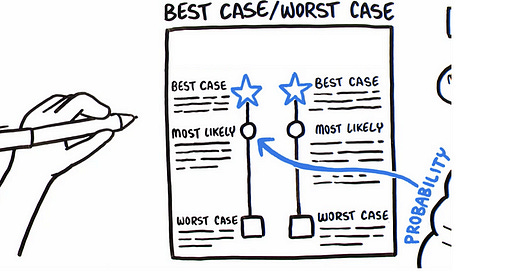From Fear to Clarity: Calibrating Decisions to Overcome our Biases
Expanding on my earlier post about effective decision-making, I’m excited to share a complementary approach that can elevate decision-making clarity. In the prior post, I stressed the significance of evaluating the effects of reversibility and consequentiality on our decisions. This post is focused on countering biases and grounding decisions in reality rather than relying on our subconscious influences.
It’s astonishing how we often default to catastrophic thinking, visualizing worst-case scenarios not by choice, but by ingrained habit. These habits stem from mental models, our mind’s internal blueprints formed by past experiences and influences. While these models help us process information efficiently, they can become rigid, pushing us towards a risk-averse mindset. Over time, these entrenched patterns can make decision-making feel overwhelming, requiring conscious effort to recalibrate and break free from their limitations.
Decision Calibration Framework
I wanted to share a simple framework that I have found helpful to ground my decisions more in reality and approach decisions with more clarity and confidence. I’m calling it the Decision Calibration Framework. Let’s dive in.
Step 1: Write out the Best Case
The most ideal outcome you can imagine. This is the scenario where everything goes according to plan, all variables align in your favor, and the end result surpasses your expectations. Dream the dream!
Why it is crucial: It provides motivation. By visualizing the best case, you get a glimpse of what’s possible, fueling your drive and determination. It reminds us of the potential upside and why we’re considering the decision in the first place.
Step 2: Write out the Worst Case
The most unfavorable turn of events. This is where all things that could go wrong, do.
Why it is crucial: It prepares you. By acknowledging the worst-case scenario, you can formulate contingency plans and emotionally brace yourself for challenges. While it may sound negative, it’s a proactive approach to potential setbacks, ensuring you’re not caught off-guard.
Step 3: Write out the Realistic (Most Likely) Case
Somewhere between the best and worst lies the most likely outcome. This scenario is based on data, past experiences, and logical reasoning.
Why it is crucial: It offers balance. The realistic case prevents us from being paralyzed by fear or blinded by over-enthusiasm. It provides a more grounded and attainable goal to strive for and a way to reprogram our minds.
Realistic (Most Likely) Case: Digging Deeper
Plotting the Realistic Case can be enlightening. Was it leaning more towards the best or worst? How did it align with your initial gut feeling? Locating it on the spectrum not only highlights your innate biases but also offers a moment of introspection. It prompts you to ask, “Why did I place it there?” or “Are my instincts anchoring me more towards the pessimistic outcome?”
A constructive way to visualize this framework is to imagine it as a bell curve of possibilities. In this curve, the Realistic Case forms the bulging center, while the Best and Worst Cases taper off on either side. A majority of outcomes likely fall within the range of the ‘Realistic’ category, indicating that it’s highly probable the result will align somewhere close to our realistic expectations. This is particularly reassuring for the risk-averse. By understanding that the Worst Case is statistically less likely, you can adjust your mindset away from the negative extremities, bringing much-needed clarity and objectivity to your decision-making process.
Tactical Steps for the Realistic Case
You might be asking: “But how do we accurately determine the Realistic Case amidst our natural inclinations towards optimism or pessimism?” Here are some practical steps:
Data Analysis: Look for empirical data related to your decision. For instance, if it’s a business decision, what does historical data indicate?
External Perspectives: Engage with peers, mentors, or experts in the relevant domain. They can provide an outsider’s perspective, free from your inherent biases.
Scenario Testing: Run simulations if possible. For instance, in a business context, if this is a two-way decision, experiment and iterate.
Feedback Mechanism: Continuously seek feedback once the decision is made. This not only helps adjust your course if needed but also fine-tunes your ability to make realistic assessments in the future.
Benefits of this Framework
When we’re bombarded with decisions, our brain can default to its primal instincts. This simple framework aids in unpacking the complexities of decision-making enabling us to more intentionally make the decision. More often than not, the realistic scenario isn’t as dire as our fears portray. By explicitly laying it out, we can see things for what they truly are, stripped of emotional biases.
When faced with short deadlines, an intimate vulnerability of mine comes to light: I often grapple with catastrophic thinking. The pressure of the ticking clock amplifies my anxieties, leading me to imagine worst-case scenarios. I envision missed opportunities, disappointed peers, or perceived personal failures, even when the reality might be far less dramatic. It’s a mental spiral where the weight of time scarcity magnifies potential pitfalls, overshadowing the more likely, and often, more positive outcomes. This self-awareness is the first step in my ongoing journey to recalibrate my responses and foster a more balanced perspective, regardless of the time constraints.
The next time you’re faced with a challenging decision (work-related, personal, career), remember this framework. By breaking down your choices into the best, worst, and realistic cases, you give yourself the permission to dream, the preparedness to face challenges, and the clarity to move forward with confidence, recognizing that you might be dramatizing the most likely outcome. Ultimately, you may discover the rewards you’ve overlooked by allowing instincts to overshadow informed decisions.
Special thanks to my teammates Sam Bauman, Matt Sherman, and Hari Joy for their feedback on this post. If you are curious to go deeper on this topic, please visit here.



